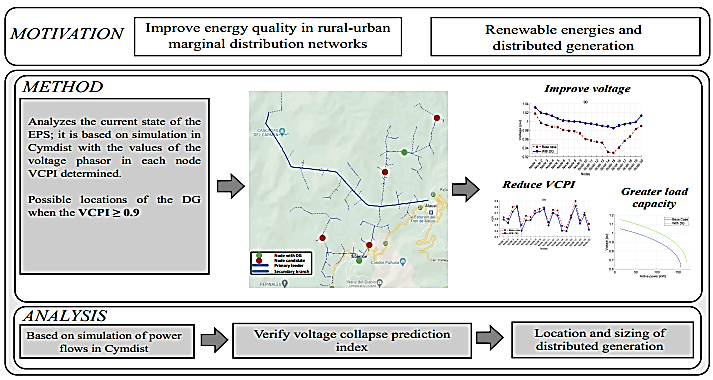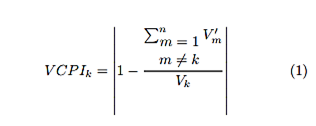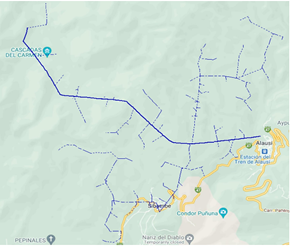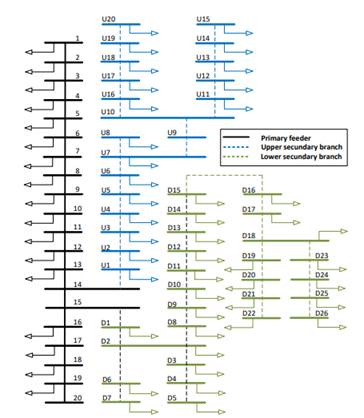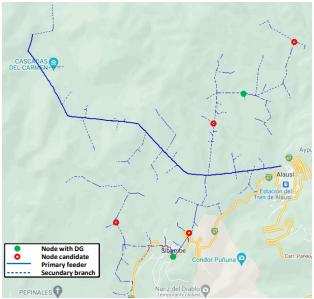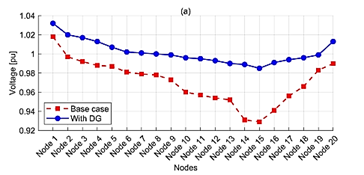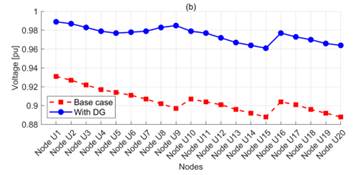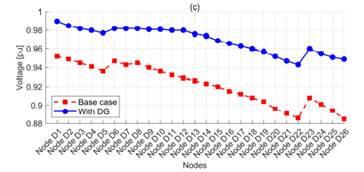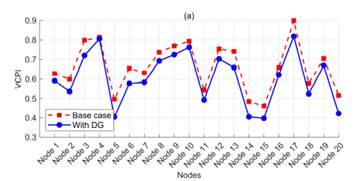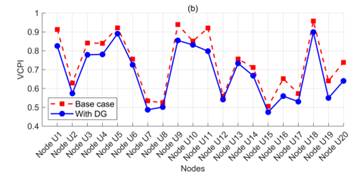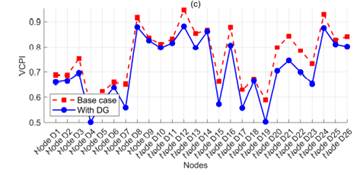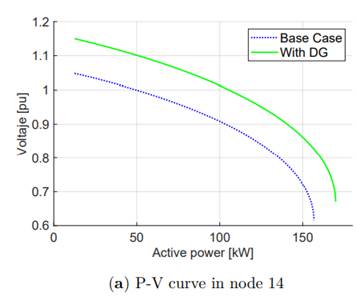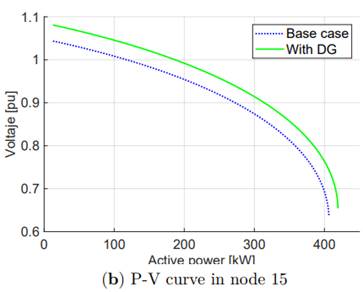|
Artículo Científico / Scientific Paper |
|
|
|
|
https://doi.org/10.17163/ings.n28.2022.02 |
|
|
|
pISSN: 1390-650X / eISSN: 1390-860X |
|
|
LOCATION OF DISTRIBUTED RESOURCES IN RURAL-URBAN
MARGINAL POWER GRIDS CONSIDERING THE VOLTAGE COLLAPSE PREDICTION INDEX |
||
|
LOCALIZACIÓN DE RECURSOS DISTRIBUIDOS EN REDES ELÉCTRICAS RURALES- URBANAS MARGINALES CONSIDERANDO EL ÍNDICE DE PREDICCIÓN DE COLPASO DE TENSIÓN |
||
|
Received: 01-06-2022, Received after review:
20-06-2022, Accepted: 22-06-2022, Published: 01-07-2022 |
|
Abstract |
Resumen |
|
This research focuses on the georeferenced
location of distributed resources, specifically the injection of active power
through distributed generation. A rural-urban marginal feeder of a
distribution company in Ecuador with georeferenced information was taken as a
case study, which has a three-phase primary link at a medium voltage and
several single-phase branches at a medium voltage of great length to supply
users who are far away from the local company’s network. Consequently, to
analyze the behavior of the electrical network, the Cymdist
software was used to perform simulations in a steady state without and with
the insertion of distributed generation. For the location of the distributed
generation, the voltage collapse prediction index was used as a technique for
quantifying and identifying problems in the network nodes. Moreover, based on
the proposed methodology, the suitable georeferencing
of the sites where it is necessary to inject active power to improve the
voltage profiles and reduce the voltage collapse prediction index was
obtained. |
Esta investigación se centra en la localización georreferenciada de los recursos distribuidos, concretamente en la inyección de potencia activa a través de la generación distribuida. Se tomó como caso de estudio un alimentador marginal rural-urbano de una empresa distribuidora de Ecuador con información georreferenciada, que cuenta con un enlace primario trifásico a media tensión y varios ramales monofásicos a media tensión de gran longitud para abastecer a usuarios alejados de la red de la empresa local. En consecuencia, para analizar el comportamiento de la red eléctrica, se utilizó el software Cymdist para realizar simulaciones en estado estacionario sin y con la inserción de generación distribuida. Para la ubicación de la generación distribuida, se utilizó el índice de predicción de colapso de tensión como técnica para cuantificar e identificar problemas en los nodos de la red. Además, a partir de la metodología propuesta, se obtuvo la georreferenciación idónea de los sitios donde es necesario inyectar potencia activa para mejorar los perfiles de tensión y reducir el índice de predicción de colapso de tensión. |
|
|
|
|
Keywords: Distributed generation, Distributed
generation, Voltage collapse prediction index, Distributed resources,
Electric power systems |
Palabras clave: Generación distribuida, Índice de predicción de colapso de voltaje, Recursos distribuidos, Sistemas eléctricos de potencia |
|
1 Master program
of bussines administrator, Indiana Tech University,
Fort Wayne - Indiana - USA. 2,*Electrical Engineering Deparment, Universidad Politécnica Salesiana, Quito - Ecuador. Corresponding author ✉: dcarrion@ups.edu.ec 3Electrical Engineering Deparment, Universidad Don Bosco, San Salvador - El Salvador. 4Electrical Engineering Deparment, Universidad Pontificia Bolivariana, Medellín - Colombia.
Suggested
citation: Lemus, A.; Carrión, D.; Aguirre, E. and
González, J. W. “Location of distributed resources in rural-urban marginal
power grids considering the voltage collapse prediction index,” Ingenius, Revista de Ciencia y Tecnología, N.◦
28, pp. 25-33, 2022, doi:
https://doi.org/10.17163/ings.n28.2022.02. |
|
1.
Introduction Electric power systems (EPS) are
currently seeking to optimize non-conventional renewable resources, and that
is why many of them have begun to change their energy matrix, betting on
solar photovoltaic, low and high enthalpy solar thermal, on-shore and
off-shore wind, and geothermal power plants. These generation plants have
incorporated new variables in the decision and optimization processes in
operation and dispatch of energy [1, 2]. The advantage of
this type of solution is that it is possible to reduce the losses in the
electric transmission systems, and therefore, it can be assured that the
power system is efficient. The presence of DG poses new challenges in the
management and operation of electricity grids. To date, it represents about
20% of the total generation of some power systems, and this figure is
gradually increasing based on the energy policies of each region. An example
of this change can be seen in Europe, where an energy system with less
dependence on non-renewable resources, with the introduction of emission
reduction policies that significantly impact electricity markets [3–6]. Another solution to
this problem is the insertion of distributed energy resources (DER), which
have also increased on the planet, thus seeking a sustainable energy system
with fewer environmental problems and greater energy efficiency. Thus, DER
management concepts have been generated, and virtual power plants (VPP) have
been created. A VPP is a single actor in the electricity market and comprises
several DERs. Within this new concept, the owners of the VPPs can access the
electricity market while compensating for the power deficit due to
intermittency in the wind and solar energy sources, accompanied by
uncertainty in the behavior of demand [7–9]. With the increased
penetration of DER in the electric grid, more flexibility is required on the
consumption side. The flexibility in DER deployed on a distribution grid can
become an attractive asset for trading in electricity markets. A VPP can
provide a demand response to an aggregator operating in the market. However,
this flexibility may be subject to user behavior, and local regulations in
the residential sector [10]. Currently, the principle of operation of VPPs is based on demand response (DR), the most widely used and researched technique. Thus commercial and industrial load management and distributed generation are the main focus of these studies. Several factors define the business models
|
under which VPPs
operate, such as financing method (market or incentives), target market
(system services, imbalance management, a day ahead, during the day,
balancing market), motivation factor (pricing structure, environmental
aspect, system aspect), customer type (residential, commercial, industrial
and street lighting), consumption characteristics (responsiveness, capacity,
reliability, frequency, duration), DG characteristics (primary resource,
responsiveness, capacity, reliability, frequency, duration), activation type
(response time, duration, changes, capacity) and control mode (manual,
semi-automatic or automatic) [11, 12]. Generally speaking,
VPPs can respond to two types of markets: marginal markets where all
generators receive the same price at the highest marginal dispatch price and
pay-per-bid markets where VPPs receive the price bid by them. The operational
management of the EPS depends on power flow studies using optimization and
simulation techniques. The optimal DC (OPF-AC) and AC (OPF-AC) flows are the
most commonly used techniques for power flow optimization. On the other hand,
specialized software such as Digsilent power
factory and Cymdist is used for simulation, which
allows the implementation of georeferenced power flow studies, from which the
different electrical parameters such as node voltage, angle, active and
reactive power flows, generation dispatch and power factor can be obtained
[13, 14]. Most studies have
focused on studying DER in urban distribution networks, where the load is
concentrated, and the benefits are achieved by establishing a
technical-economic balance. However, the studies are scarce for rural and
marginal urban distribution networks, so this research focuses on identifying
the DER connection point based on simulation techniques in a rural
georeferenced distribution system [15–17]. Through the results
obtained from the simulation, the voltage collapse prediction index is
determined in each node. In the nodes where the index is close to 1, it
becomes a candidate node to locate a DER so that the DER connection points
are determined later through the proposed heuristic methodology. For this
purpose, the voltage profile, the loss reduction, and the power factor
improvement are verified. Figure 1 shows the conceptualization of ideas
raised in this research. The article is
organized as follows: section 2 refers to the concepts related to distributed
resources, section 3 defines the problem and the case studies, section 4
analyzes the results, and section 5 shows the main conclusions. |
|
Figure 1. Research conceptualization |
|
|
1.1.
Related Works One of the alternatives available
in current EPS to alleviate congestion in the distribution and transmission
networks is distributed energy resources (DER), a set of technologies that
can be deployed in the electric grid. Among these is distributed generation,
which seeks to generate electricity very close to the consumption points.
Other technologies used are the Battery Energy Storage Systems (BESS), which
seek to store the energy that is not used during low-demand hours so that it
can be used during peak hours, thus reducing the demand for a centralized
generation. 1.1.1.
Distributed
generation Distributed generation has become
one of the primary sources of non-conventional natural resources for
electricity generation at sites very close to the load. Thus, DG is connected
to distribution networks at medium or low voltage levels, depending on the
type of contract and its power. The leading primary energy used for
electricity generation in DG is solar, specifically solar photovoltaic, which
can be implemented from small plants located on the terraces of residences to
generation complexes that can reach up to MW of installed power [18–20]. The DG has made it
necessary for distribution systems to become bi-directional networks, thereby
reducing congestion in transmission networks and losses in power systems. Now
users can be part of the electricity market, producing their energy and
injecting the surplus into the public grid, [21, 22]. The energy management
of the DG is carried out through the VPPs that allow an optimal dispatch |
of resources based on measurement
and monitoring systems of the DG, the BESS, and controllable load resources.
The control strategy of VPPs can be divided into three different patterns:
centralized control, distributed control, and fully distributed control;
according to their structure and information, depending on the roles and
responsibility, VPP is distinguished as commercial VPP (CVPP), technical VPP
(TVPP) and combined VPP [7, 23]. Communications play a
fundamental role in the operation and management of the VPP. It is possible
to have an online measurement in time of the primary energy resources that
are used for electricity generation, the necessary demand in each time
interval, imbalances in the networks, and uncovered energy needs that must be
imported from public networks for adequate demand management [24, 25]. 1.1.2.
Voltage
collapse prediction index In the operation of power systems,
many parameters define the behavior of EPS, such as power quality indexes,
stability indexes, reliability indexes, voltage profile, and line
chargeability, among others. Power flow studies allow quantifying each of the
electrical parameters in the EPS steady-state operation and are the
mathematical tool used by simulators to show the behavior of power systems
under different generation and demand scenarios. There are different
reliability and stability indexes to verify the state of power systems. For
example, the EPS are analyzed under the N-1 contingency state to study
reliability. For this purpose, the contingency ranking index is used to
determine the degree of contingency affectation, thus obtaining information
that will help plan the expansion and improvement of the EPS. |
|
On the other hand,
different indexes have been proposed to identify voltage, angle, frequency,
chargeability, and load fluctuation failures [26–29]. The identification
of the operative limits allows determining nodes with a deficiency in which
the power system must be improved so that through the VCPI, it is possible to
locate problem nodes in which, before any change in the load the power system
can collapse, the VCPI is determined through (1) [30]. VCPI is based on the
electrical network’s voltage phasors and admittance characteristics and
calculated for each node of the EPS. The VCPI values are between 0 and 1, and
the closer it is to 1, the higher the probability of voltage collapse at that
node.
|
Where: Vm is the voltage phasor at node m, Vk is the voltage phasor at node k, Ykm is the admittance between nodes k
and m, Ykj is the admittance between nodes k and j. The VCPI is a global
technique that considers the effects of the loads in the other nodes on a
particular node, which can be linked to the voltage stability studies
achieved by analyzing the P-V curves; therefore, it can be said that the VCPI
can predict a node in which voltage instability may occur in power systems. Table 1 shows
significant contributions in planning electrical distribution systems, which
in recent years have focused on topics such as renewable energies,
distributed resources, distributed generation, virtual power plants, and
demand management. The principal electrical parameters analyzing by other
authors are voltage, congestion, power factor, and Geo-referenced.
|
|
Table 1. Summary of related Works
|
|
|
|
|
|
2.
Materials and
methods 2.1.
Problem
and Methodology Feeder 1500090T01 of the Riobamba
electric company (EERSA S.A.) has been taken as a case of analysis since the
concession area of the distribution company corresponds to rural and marginal
urban networks in its more significant percentage. Feeder 1500090T01 is shown
in figure 2, in which it can be seen that it has two (2) links to the
sub-transmission ring and two single-phase derivations to the users; as can
be seen, the coverage of this feeder is 100% rural, where its users are far
away from each other, and there are service quality problems. As it is a
marginal urban, rural network, only the primary link is three-phase, and all
the branches are single-phase, which generates an additional problem about
the power balance, so it is assumed that the location of the proposed DG will
be adapted to the voltage profiles and several phases existing at the
connection point. |
Figure 2. Feeder
1500090T01 of EERSA S.A. Source: Cymdist |
|
Figure 3 shows the
equivalent single-line diagram of the power system considered for the
analysis, in which the two secondary branches can be distinguished. The nodes
of the secondary branches are identified by the letter U for the upper
branch. And by the letter D for the lower branch. The upper branch comprises
20 nodes connected by the end-users, and the lower branch has 26 nodes.
Figure 3. Feeder 1500090T01 of EERSA
S.A. Source: Cymdist The
analysis of the power flows performed through simulation in Cymdist, with which the current state of the network is
obtained, data that are the starting point for the location of distributed
resources in the network; with these values, we proceed to determine the
VCPI. Since there are different voltage profiles, the studies will be carried
out in p.u., values whose base is referred to as
the main three-phase link, in such a way that the different electrical
variables are unified. Algorithm 1 defines the methodology for DG insertion
in the nodes that present a VCPI very close to 1, assuming the existence of
the primary resource, physical space, and without generating a more
significant environmental impact. Table 2. Variables related to the
mathematical model |
The methodology to
ideal deploy DG in power systems is shown in Algorithm 1, in which VCPI is
considered the primary constraint; in Step 1, the EPS steady-state simulation
in Cymdist is considered, and the different
electrical parameters are stored. In Step 2, the steady-state of the power
system is analyzed, and the VCPI at each node is determined. In Step 3, the
VCPI comparison is performed, and the highest VCPI values are taken as possible
DG locations. In Step 4, the location and sizing of the DG are performed.
Finally, in Step 5, the results of the proposed methodology applied in the
simulation in Cymdist are shown. For the sizing of
the DG, 1 kW steps were considered, comparing the previous VCPI with the new
one, as well as voltage profiles and line congestion. Table 2 shows the
notation of variables used in Algorithm 1. The proposed methodology analyzes
the current state of the EPS; it is based on simulation in Cymdist, |
|
with the values of the voltage
phasor in each node VCPI determined. This index is the decision parameter for
the possible locations of the DG when the VCPI ≥ 0.9, each node which,
after implementing DG, reduces its VCPI ≤ 0.9 is considered like nodes
in which DG should be implemented. In this way, once it has the possible
locations, place the DG in those nodes, and if it does not reduce the VCPI,
the node is discarded. For DG sizing, incremental steps of 1kW were performed
until the EPS obtains a VCPI value of ≤ 0.9 at all nodes. Once the
nodes in which DG should be implemented and its power capacity are
determined, the current state is analyzed, and it is verified if it improved
the voltage profile and stability by analyzing the P-V crossovers. 3.
Results and
discussions 3.1.
Analysis of
Results This index identified the possible
nodes where DG can be located to improve the indicator above without
affecting the other electrical parameters. Based on the simulation in the Cymdist software, the EPS steady-state power flows were
obtained, and with this, applying algorithm one and based on the voltage
phasors, the VCPI at each node was determined. The location of the possible
nodes and the final location of the DG can be seen in Figure 2.
Figure 4. DG georeferenced location As shown in Figure 4, the location
of the DG is not in the three-phase network but in two of the singlephase branches, which is why the DG systems must
also be single-phase. The DG system in the upper branch is sized with a value
of 17 kW at node U8, whose coordinates are Lat.: -2.1669009, Long.:
-78.8633971. The value includes the VCPI improved in all the nodes of that
branch. |
On the other
hand, in the lower branch, the DG power was 32 kW at node D12, whose
coordinates are Lat.: -2.2292529, Long.: -78.8900419, which, as in the lower
branch, improves the VCPI of the entire branch. The voltage profile
in the main feeder can be seen in Figure 5 (a) and in the upper branch Figure
5 (b) and lower Figure 5 (c); in the three cases, it can be seen how the
voltage improves after the DG enters the points selected by the proposed
methodology. On the other hand, Figure 6 shows the comparison of the VCPI
before and after DG insertion, both for the main feeder (a) and the upper (b)
and lower (c) branches.
Figure 5. Voltage profile at nodes VCPI try to reduce their original
values, so it can be asserted that the quality of electrical service improves
in these branches, which is undoubtedly one of the electrical parameters that
power system planners are looking for nowadays. Considering that modifications
have been made to the EPS compared to its initial state, it is necessary to
verify the overall operation of the distribution network, and one way to do
this is to analyze the system’s stability. For the proposed case based on the
VCPI, it is necessary to study the voltage stability, which is done |
|
through the P
- V curves. Consequently, the nodes of the main feeder where the secondary
branches are connected, nodes 14 and 15, have been considered.
Figure 6. VCPI at nodes Figure 7 (a) shows
the P-V curve for node 14. It can be seen how the voltage increases with the
fluctuation of the total load of the upper branch, similar to the Hopf bifurcation shifts to the right. A similar situation
can be seen in Figure 7 (b), showing the results at node 15, which feeds the
lower branch.
|
Figure 7. P - V curves (a)
Node 14. (b) Node 15 4.
Conclusions The different studies that can be achieved
through simulation techniques are innumerable. They are often despised due to
the lack of interface or knowledge to extract their parameters and use them
in modeling programs such as Matlab or Phyton. For the case study presented, the databases of
the results were extracted. Through Matlab, the
proposed methodology was implemented based on the results, thus ideal
locating the possible points at which power can be injected from a DG. The
location and sizing of the DG improved the voltage profiles of the entire
EPS, contrary to what happens when reactive compensation is performed, which
only improves the voltage profile in the vicinity of the reactive injection
point. It was possible to demonstrate
that through the VCPI, it is possible to detect nodes with weaknesses in the
power system, and this can be used for different studies; for the case
proposed through the analysis of this parameter, it was possible to locate
and dimension two active power injection points in a distribution network. It is possible to analyze
georeferenced power systems with georeferenced data and not only have the
examples stipulated in the literature, such as the CIGRÉ and IEEE models. It
is now possible to access the databases of distribution companies and provide
real solutions to their problems. It is essential to highlight that through Cymdist. The georeferencing
of the active power injection point is very useful to contrast with the
existing primary resources at the site and determine what type of primary
energy can be used to solve the drawbacks of the power grid. References [1] P.
Del Río and P. Mir-Artigues, “Combinations of
support instruments for renewable electricity in Europe: A review,” Renewable
and Sustainable Energy Reviews, vol. 40, pp. 287–295, 2014. [Online].
Available: https://doi.org/10.1016/j.rser.2014.07.039 |
|
[2] M. A. Salmani, A. Anzalchi, and S. Salmani, “Virtual Power Plant: New Solution for Managing Distributed Generations in Decentralized Power Systems,” in 2010 International Conference on Management and Service Science, 2010, pp. 1–6. [Online]. Available: https://doi.org/10.1109/ICMSS.2010.5577383
[3] F. Mosquera, “Localización óptima de plantas virtuales de
generación en sistemas eléctricos de potencia basados en flujos óptimos de
potencia,” I+D Tecnológico, vol. 16, no. 2, 2020. [Online]. Available: https://doi.org/10.33412/idt.v16.2.2827 [4] A. Riofrio and D. Carrión,
“Approach and Deployment of Distributed Generation. State-of-art Based on
Induction Cooker System,” in ANDESCON 2014, 2014. [Online]. Available:
https: //doi.org/10.1109/ANDESCON.2014.7098544 [5] S. Singh, A. R. Gautam, and D. Fulwani,
“Constant power loads and their effects in DC distributed power systems: A
review,” Renewable and Sustainable Energy Reviews, vol. 72, no.
December 2015, pp. 407–421, 2017. [Online]. Available: https://doi.org/10.1016/j.rser.2017.01.027 [6] Z. Ren, W. Yan,
C. Ding, J. Yu, and X. Zhao, “Probabilistic optimal power flow analysis of
virtual power plant containing photovoltaic generation,” Asia-Pacific
Power and Energy Engineering Conference, APPEEC, vol. 2015- March, no.
March, 2014. [Online]. Available: https://doi.org/10.1109/APPEEC.2014.7066012 [7] H. Saboori, M. Mohammadi, and R. Taghe, “Virtual power plant (VPP), definition, concept,
components and types,” Asia-Pacific Power and Energy Engineering
Conference, APPEEC, 2011. [Online]. Available: https://doi.org/10.1109/APPEEC.2011.5749026 [8] P. Nezamabadi and G. Gharehpetian,
“Electrical energy management of virtual power plants in distribution
networks with renewable energy resources and energy storage systems,” 16th
Electrical Power Distribution Networks Conference, pp. 1–5, 2011.
[Online]. Available: https://bit.ly/3ygQznn [9] M. Peikherfeh, H. Seifi, and M. K.
Sheikh-El- Eslami, “Optimal dispatch of distributed
energy resources included in a virtual power plant for participating in a
day-ahead market,” 3rd International Conference on Clean Electrical Power:
Renewable Energy Resources Impact, ICCEP 2011, pp. 204–210, 2011. [Online].
Available: https://doi.org/10.1109/ICCEP.2011.6036275 |
[10] L. Exel and G. Frey, “Toward a decentralized forecast system
for distributed power generation,” ENERGYCON 2014 - IEEE International
Energy Conference, pp. 1210–1217, 2014. [Online]. Available: https:
//doi.org/10.1109/ENERGYCON.2014.6850577 [11] L.
Hernandez, C. Baladron, J. Aguiar,
B. Carro, A. Sanchez-Esguevillas,
J. Lloret, and J. Massana,
“A Survey on Electric Power Demand Forecasting: Future Trends in Smart Grids,
Microgrids and Smart Buildings,” Communications
Surveys & Tutorials, IEEE, no. 99, pp. 1–36, 2014. [Online].
Available: https: //doi.org/10.1109/SURV.2014.032014.00094 [12] P. Asmus, “Microgrids, Virtual
Power Plants and Our Distributed Energy Future,” The Electricity Journal,
vol. 23, no. 10, pp. 72–82, 2010. [Online]. Available: https://doi.org/10.1016/j.tej.2010.11.001 [13] F. Quinteros, D. Carrión, and M.
Jaramillo, “Optimal Power Systems Restoration Based on Energy Quality and
Stability Criteria,” Energies, vol. 15, no. 6, 2022. [Online].
Available: https://doi.org/10.3390/en15062062 [14] T.
Kishore and S. Singal, “Optimal economic planning
of power transmission lines: A review,” Renewable and Sustainable Energy
Reviews, vol. 39, pp. 949–974, 2014. [Online]. Available: https://doi.org/10.1016/j.rser.2014.07.125 [15] V.
C. Güngör, D. Sahin, T. Kocak, S. Ergüt, C. Buccella, S. Member, C. Cecati,
and G. P. Hancke, “Smart Grid Technologies:
Communication Technologies and Standards,” IEEE Transactions on Industrial
Informatics, vol. 7, no. 4, pp. 529–539, 2011. [Online]. Available: https://doi.org/10.1109/TII.2011.2166794 [16] U. Akpan, M. Essien, and S. Isihak, “The impact of rural electrification on rural
microenterprises in niger delta, nigeria,” Energy for Sustainable Development, vol.
17, no. 5, pp. 504–509, 2013. [Online]. Available: http://dx.doi.org/10.1016/j.esd.2013.06.004 [17] D. Carrion, E. García, J. Gonzalez, I. Isaac, G. Lopez, and R. Hincapie, “Método Heurístico de Ubicación Óptima de Centros de Transformación y Enrutamiento de Redes Eléctricas de Distribución,” Revista Técnica "Energía", vol. 4, no. 2, p. 20, 2015. [Online]. Available: https://doi.org/ 10.37116/REVISTAENERGIA.V13.N1.2017.1 |
|
[18] S. Heang and V. Vai, “Optimal
Network Reconfiguration with DGs Placement and Sizing in a Distribution
System Using Hybrid SOE and GA,” in 2022 19th International Conference on
Electrical Engineering/Electronics, Computer, Telecommunications and
Information Technology (ECTI-CON), no. 1. IEEE, 2022, pp. 2–5. [Online].
Available: https://doi.org/10.1109/ ECTI-CON54298.2022.9795530 [19] M. A. Aderibigbe, A. U. Adoghe, F. Agbetuyi, and A. E. Airoboman,
“A review on optimal placement of distributed generators for reliability
improvement on distribution network,” 2021 IEEE PES/IAS PowerAfrica, PowerAfrica 2021,
2021. [Online]. Available: https://doi.org/10.1109/
PowerAfrica52236.2021.9543266 [20] S. K. Sena, “An Approach to Detect Islanding in Photovoltaic
Based Distributed Generation Systems using Sequence Components of Voltage,”
in 2022 IEEE International Conference on Distributed Computing and
Electrical Circuits and Electronics (ICDCECE). IEEE, 2022, pp. 1–6.
[Online]. Available: https://doi.org/10.1109/ ICDCECE53908.2022.9792918 [21] W. Pavón, E. Inga, and S. Simani,
“Optimal routing an ungrounded electrical distribution system based on
heuristic method with micro grids integration,” Sustainability, vol.
11, no. 6, pp. 1–18, 2019. [Online]. Available: https://doi.org/10.3390/su11061607 [22] E. Inga, M. Campaña, and R. Hincapié,
“Optimal Sizing of Electrical Distribution Networks considering Scalable
Demand and Voltage,” 2018 IEEE 1st Colombian Conference on Applications in
Computational Intelligence, ColCACI 2018 - Proceedings,
vol. 1, no. 1, pp. 1–6, 2018. [Online]. Available: https://doi.org/10.1109/ColCACI.2018.8484859 [23] A. Valenzuela, I. Montalvo, and E. Inga, “A decision-making tool for electric distribution network planning based on heuristics and georeferenced data,” Energies, vol. 12, no. 21, 2019. [Online]. Available: https://doi.org/10.3390/en12214065 |
[24] F. Heimgaertner and M. Menth, “Distributed Controller
Communication in Virtual Power Plants Using Smart Meter Gateways,” 2018
IEEE International Conference on Engineering, Technology and Innovation,
ICE/ITMC 2018 - Proceedings, pp. 1–6, 2018. [Online]. Available: https://doi.org/10.1109/ICE.2018.8436311 [25] A. Valenzuela,
E. Inga, and S. Simani, “Planning of a Resilient
Underground Distribution Network Using Georeferenced Data,” Energies,
vol. 12, no. 4, p. 644, 2019. [Online]. Available: http://www.mdpi.com/1996-1073/12/4/644 [26] M. S. S.
Danish, T. Senjyu, S. M. S. Danish, N. R. Sabory, K. Narayanan, and P. Mandal, “A recap of voltage
stability indices in the past three decades,” Energies, vol. 12, no.
8, pp. 1–18, 2019. [Online]. Available: https://doi.org/10.3390/en12081544 [27] R. Mahanty and P. Gupta, “Voltage stability analysis in
unbalanced power systems by optimal power flow,” IEE Proceedings -
Generation, Transmission and Distribution, vol. 151, no. 3, pp. 201–212,
2004. [Online]. Available: https://doi.org/10.1049/ip-gtd:20050011 [28] D. Carrión, E. García, M.
Jaramillo, and J. W. González, “A Novel Methodology for Optimal SVC Location
Considering N-1 Contingencies and Reactive Power Flows Reconfiguration,” Energies,
vol. 14, no. 20, pp. 1–17, 2021. [Online]. Available: https://doi.org/10.3390/en14206652 [29] D. Carrión, J. Palacios, M. Espinel,
and J. W. González, “Transmission Expansion Planning Considering Grid
Topology Changes and N-1 Contingencies Criteria,” in Recent Advances in
Electrical Engineering, Electronics and Energy, Springer, Ed. Springer,
pp. 266–279. [Online]. Available: https://doi.org/10.1007/978-3-030-72208-1_20 [30] I. A. Samuel, J. Katende, C. O. Awosope, and A. A. Awelewa, “Prediction of voltage collapse in electrical power system networks using a new voltage stability index,” International Journal of Applied Engineering Research, vol. 12, no. 2, pp. 190–199, 2017. [Online]. Available: https://bit.ly/39Orhn8 |
